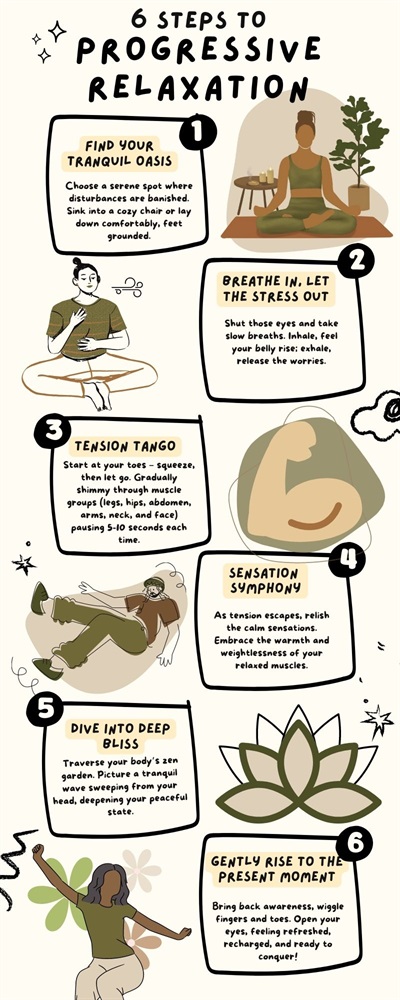The Art and Science of Progressive Relaxation

In a fast-paced world filled with stress and constant demands, finding moments of tranquility and relaxation is essential for maintaining overall well-being. Progressive relaxation, a scientifically validated technique, offers a methodical approach to achieving deep relaxation by systematically releasing tension from the body and calming the mind. In this article, we will delve into the concept of progressive relaxation, explore the science behind its effectiveness, and provide a step-by-step guide on how to practice it.
During the process of progressive relaxation, the body's relaxation response is activated. This response triggers the parasympathetic nervous system, which is responsible for rest and digestion. As muscle tension decreases, heart rate and blood pressure may also lower, leading to an overall sense of calmness and relaxation.

What is Progressive Relaxation?
Progressive relaxation is a relaxation technique that involves deliberately tensing and then releasing different muscle groups in the body to induce a state of deep physical and mental relaxation. It was developed by Dr. Edmund Jacobson in the early 20th century as a way to alleviate stress and promote relaxation.The Science Behind Progressive Relaxation
Progressive relaxation is rooted in the principles of the mind-body connection and the body's response to stress. When stress or anxiety is experienced, the body's muscles tend to tense up, which can lead to discomfort and further stress. Progressive relaxation works by interrupting this cycle and promoting relaxation through muscle relaxation.During the process of progressive relaxation, the body's relaxation response is activated. This response triggers the parasympathetic nervous system, which is responsible for rest and digestion. As muscle tension decreases, heart rate and blood pressure may also lower, leading to an overall sense of calmness and relaxation.
Benefits of Progressive Relaxation:
Incorporating progressive relaxation into your routine can offer a wide range of benefits that positively impact your physical, mental, and emotional health, including:- Stress Reduction: By systematically releasing muscle tension, progressive relaxation helps alleviate stress, promoting a more peaceful state of mind.
- Improved Sleep Quality: Practicing progressive relaxation before bedtime can relax the body and mind, leading to better sleep quality.
- Muscle Relaxation: This technique effectively reduces physical tension, relieving muscle stiffness and discomfort.
- Anxiety Management: Regular practice can help manage anxiety by teaching the body how to respond to stressors in a calmer manner.
- Enhanced Mind-Body Connection: Progressive relaxation fosters a deeper awareness of bodily sensations, promoting mindfulness and self-awareness.
- Blood Pressure Regulation: The relaxation response triggered by this technique can contribute to lower blood pressure levels.
- Enhanced Focus and Concentration: By reducing mental clutter and promoting relaxation, progressive relaxation can improve focus and cognitive function.
- Emotional Well-being: The release of physical tension often corresponds with reduced emotional tension, leading to improved overall emotional well-being.
Step-by-Step Guide to Progressive Relaxation
Follow these steps to practice progressive relaxation and experience its benefits:- Find a Quiet Space: Choose a quiet and comfortable space where you won't be disturbed. You can either lie down on a comfortable surface or sit in a comfortable chair with your feet flat on the ground and your hands resting on your lap.
- Focus on Your Breath: Close your eyes and take a few slow, deep breaths. Inhale deeply through your nose, allowing your abdomen to rise, and then exhale slowly through your mouth. Focus on the sensation of your breath as you inhale and exhale.
-
Tense and Release: Begin with your toes. Curl them tightly for a few seconds, then release and let them relax completely. Notice the difference between tension and relaxation. Move your focus gradually up through your body, tensing and then releasing each muscle group. Progress through these muscle groups, spending about 5-10 seconds tensing and then releasing each group:
- Calves and feet
- Thighs
- Hips and buttocks
- Abdomen
- Chest and back
- Shoulders
- Arms and hands
- Neck and throat
- Face (including jaw and forehead)
- Focus on Sensations: As you release tension in each muscle group, pay attention to the sensation of relaxation. Feel the warmth and heaviness in the relaxed muscles. Imagine tension melting away, leaving your body in a state of comfort.
- Deepen Your Relaxation: Once you have gone through all the muscle groups, take a few moments to focus on your entire body. Imagine a wave of relaxation washing over you from head to toe, further deepening your state of relaxation.
- Gradual Awareness: Gently bring your awareness back to your surroundings. Wiggle your fingers and toes, and when you're ready, open your eyes.

